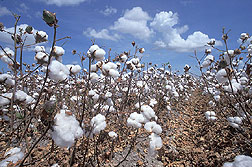This page has been archived and is being provided for reference purposes only. The page is no longer being updated, and therefore, links on the page may be invalid.
|
|
|
|
Technology Reduces Gossypol in Cotton Seed
By Alfredo FloresJanuary 12, 2007
Genetic technology developed by Agricultural Research Service (ARS) scientists and cooperators suggests that cottonseed could one day become a significant source of low-cost protein for the developing world.
The research team, headed by Keerti Rathore at the Institute for Plant Genomics and Biotechnology, Texas A&M University, and ARS chemists Robert D. Stipanovic and Lorraine S. Puckhaber in College Station, Texas, found a way to genetically reduce the amount of the natural toxin known as gossypol in cottonseed.
Stipanovic and Puckhaber are with the ARS Cotton Pathology Research Unit, part of Southern Plains Agricultural Research Center in College Station.
The research team showed that by coupling what's known as RNA interference technology, or RNAi, with a seed-specific gene promoter, it's possible to significantly reduce gossypol levels within cottonseed and not reduce the levels of gossypol and related compounds in the foliage. The presence of these compounds in the foliage helps protect the plant from attack by insects.
Gossypol is a toxic pigment that can be safely ingested only by ruminant animals with complex stomachs, so most of the nutritious meal produced during cottonseed processing is currently sold as cattle feed.
Use of the RNAi technology to develop new cotton lines could lead to plants with low enough gossypol levels in the seed that the 44 million metric tons of cottonseed produced yearly could be used to provide roughly 10 million metric tons of protein. This would help meet the total protein needs of almost a half billion people.
In addition, U.S. consumers craving a new and nutritious snack food could soon be reaching for crunchy "TAMU nuts," which were developed at Texas A&M over 20 years ago. Reduced-gossypol cotton seeds have a nutty flavor and crunch.
The research was published in a recent edition of the Proceedings of the National Academy of Sciences.
ARS is the U.S. Department of Agriculture's chief scientific research agency.

